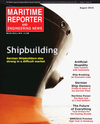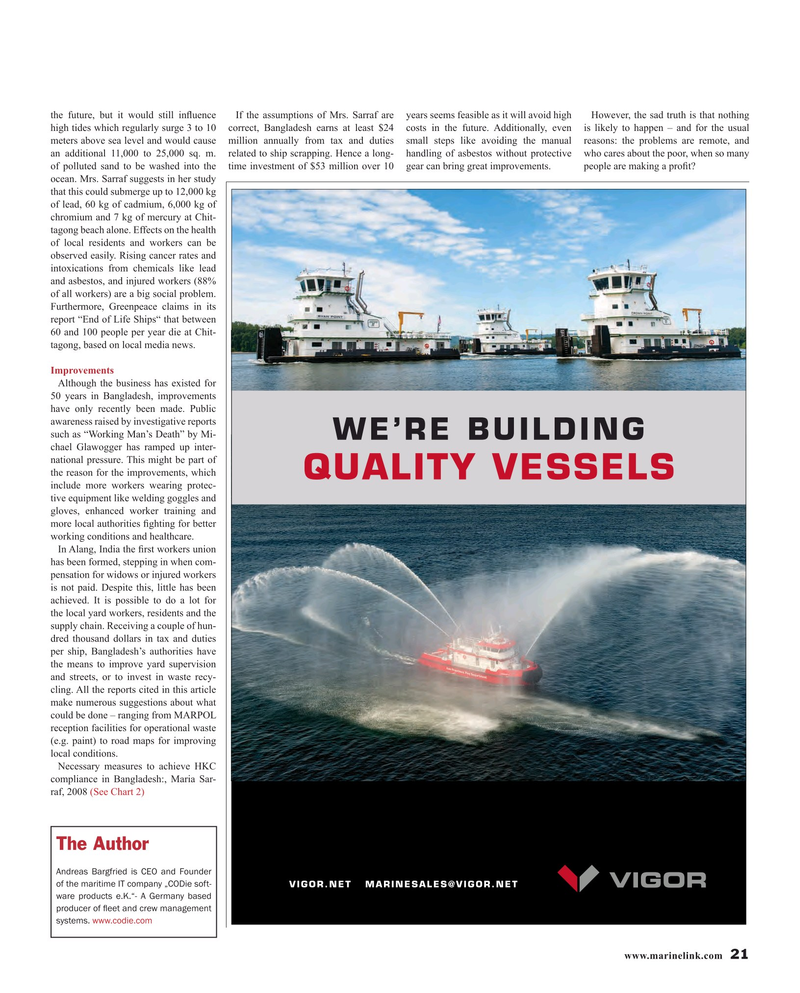
Page 21: of Maritime Reporter Magazine (August 2016)
The Shipyard Edition
Read this page in Pdf, Flash or Html5 edition of August 2016 Maritime Reporter Magazine
the future, but it would still in? uence If the assumptions of Mrs. Sarraf are years seems feasible as it will avoid high However, the sad truth is that nothing high tides which regularly surge 3 to 10 correct, Bangladesh earns at least $24 costs in the future. Additionally, even is likely to happen – and for the usual meters above sea level and would cause million annually from tax and duties small steps like avoiding the manual reasons: the problems are remote, and an additional 11,000 to 25,000 sq. m. related to ship scrapping. Hence a long- handling of asbestos without protective who cares about the poor, when so many of polluted sand to be washed into the time investment of $53 million over 10 gear can bring great improvements. people are making a pro? t? ocean. Mrs. Sarraf suggests in her study that this could submerge up to 12,000 kg of lead, 60 kg of cadmium, 6,000 kg of chromium and 7 kg of mercury at Chit- tagong beach alone. Effects on the health of local residents and workers can be observed easily. Rising cancer rates and intoxications from chemicals like lead and asbestos, and injured workers (88% of all workers) are a big social problem.
Furthermore, Greenpeace claims in its report “End of Life Ships“ that between 60 and 100 people per year die at Chit- tagong, based on local media news.
Improvements
Although the business has existed for 50 years in Bangladesh, improvements have only recently been made. Public awareness raised by investigative reports such as “Working Man’s Death” by Mi-
WE’RE BUILDING chael Glawogger has ramped up inter- national pressure. This might be part of the reason for the improvements, which
QUALITY VESSELS include more workers wearing protec- tive equipment like welding goggles and gloves, enhanced worker training and more local authorities ? ghting for better working conditions and healthcare.
In Alang, India the ? rst workers union has been formed, stepping in when com- pensation for widows or injured workers is not paid. Despite this, little has been achieved. It is possible to do a lot for the local yard workers, residents and the supply chain. Receiving a couple of hun- dred thousand dollars in tax and duties per ship, Bangladesh’s authorities have the means to improve yard supervision and streets, or to invest in waste recy- cling. All the reports cited in this article make numerous suggestions about what could be done – ranging from MARPOL reception facilities for operational waste (e.g. paint) to road maps for improving local conditions.
Necessary measures to achieve HKC compliance in Bangladesh:, Maria Sar- raf, 2008 (See Chart 2)
Aluminum, steel, small,
The Author medium or large the
Andreas Bargfried is CEO and Founder
Kvichak/Vigor team is of the maritime IT company „CODie soft- VIGOR.NET [email protected] ready to build it for you. ware products e.K.“- A Germany based producer of ? eet and crew management systems. www.codie.com www.marinelink.com 21
MR #8 (18-25).indd 21 8/1/2016 2:06:57 PM

 20
20

 22
22
